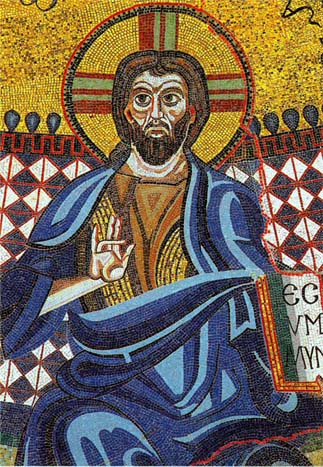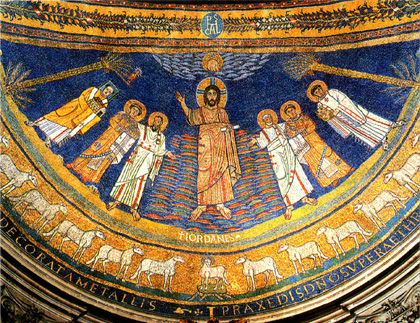







|
Roman Style In direct contrast to earlier mosaic depictions of many Roman gods, which were most often constructed on the floor, the later images containing only the godly figure of Christ were predominantly constructed on the ceilings of churches, baptisteries, and cathedrals. This inherently gives the images a very superior, heavenly feel, and the floors tended to be avoided in the production of a mosaic during the later years of the Roman Empire. For observations concerning the texture of mosaics in general, see the section concerning physical aspects of multiple-god images. The very refined texture and detailed feeling conveyed with the use of tiles is similarly reflected in the later mosaic representations and added to the aura of superiority, for the great level of detail gives an impression of perfection to the viewer. Symmetry is a common visual aid involved in the later depictions of Christ. As opposed to the earlier mosaics, in which symmetry was rarely put into practice, many symmetrical designs enhanced the borders and backgrounds of the depictions of Christ, a balanced number of figures on either side, and is also evident in the figure himself, for many of the illustrations appear to have symmetrical facial features as well as bodily features.
In order to separate figures from each other, more space is generally used, adding to the already blocky, spaced-out nature inherent to mosaic designs. Figures are able to be portrayed more prominently with a greater separation from the rest of the image
A very unique idea of power is conveyed with the visual devices put into play in Roman mosaic art depicting a single god. Instead of an aggressive, commanding figure, Christ is portrayed as a more solemn, respectful, distinguished character. He is commonly enlarged and centered in relation to the rest of the image.
Most often, smaller adoring, praising figures are portrayed surrounding the figure of Christ. These followers and adorers are involved in the creation of a superior aura around the god figure. All attention is directed to Christ, and the viewer’s attention is intended to mimic this focus of attention. In order to convey a feeling of power, the figure stands tall, is dressed in robes, is surrounded by riches and adorers, and even may be depicted as hovering above the ground, even while his followers may be planted on the ground. There is a sense of rule over the other figures, but with more of a sense of superiority and knowledge, rather than strength or courage evident in the earlier depictions of multiple gods. However, there is always an expression of care apparent on Christ’s face; this may be evidence of the god’s sympathy toward humanity.
|

 .
.


